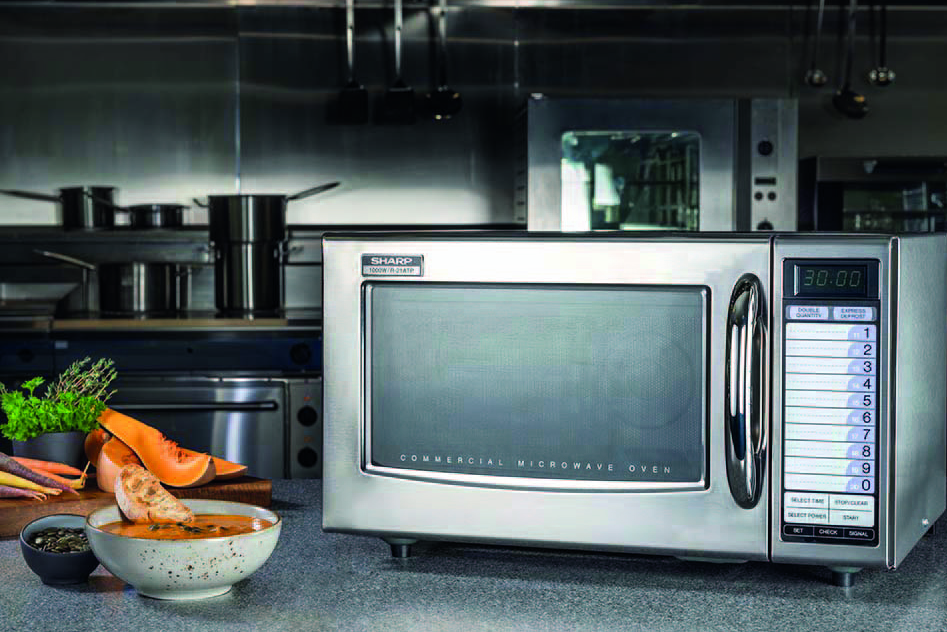
Commercial microwaves can help make food prep more efficient during busier times
WITH summer just around the corner, bar and pub operators across Scotland will be hoping a spot of warmer weather encourages customers out of their homes and into the country’s hospitality venues.
But even as it hopefully increases turnover, a busier venue can bring its own set of challenges and operators will be keen to seek out any efficiencies they can to ensure their premises are running like clockwork over the summer season.
With speed and efficiency of the essence, catering equipment specialists have pointed to one of the kitchen’s most reliable appliances, the microwave, as an essential tool for the coming months.
“Where would we be without the humble microwave oven?” said Paul Anderson, chair of the Foodservice Equipment Association (FEA).
“Once upon a time chefs were embarrassed to admit to owning one. Not anymore. These days they are everywhere, an incredibly useful and versatile friend that helps in the kitchen, café, coffee shop and bar.
“Mind you, they’re not so humble anymore.
“Rapid cook technology has advanced in leaps and bounds, so now there’s a vast choice of turbo microwaves and the like that can heat, brown and toast swiftly, efficiently and with satisfyingly tasty and crunchy results. A far cry from the soggy bottomed pie.”
Advancements in technology haven’t consigned the ‘standard’ microwave to history, said Anderson.
“Modern designs mean that the heat energy is more effectively distributed, so that the old problem of hot or cool spots should be a thing of the past,” he said.
“And the simple microwave is great for all sorts of useful tasks, from a quick blast of heat to a fast defrost.
“It’s also pretty good at some prime cooking jobs, like steaming or making sauces.
That versatility was also highlighted by Duncan Vipas, head of sales at RH Hall, who said the breadth of foods that can be prepared in a commercial microwave ‘can often be overlooked’.
“Many foods and dishes can be cooked very, very well in a microwave oven,” said Vipas.
“Sauces, meat, fish, vegetables, fruit, pasta, rice and eggs can all be cooked with great results. With inverter technology now available on some models, operators can consider foods that might not normally suit microwave cooking.
“A traditional microwave set at 50% will pulse by switching power on and off throughout the cooking period, which can lead to uneven results in some foods.
“Inverter technology will provide a precise and constant supply of power at 50%, making it easier to cook or reheat foods slowly and defrost dishes to perfection.
“Thanks to precise temperature control, you can cook, reheat or defrost a far greater variety of dishes that conventional microwaves were previously not able to prepare to the same high standard.
“By providing the operator with precision control, it is perfect for defrosting or heating delicate foods, as well as providing ultra-fast regeneration times with a high power 1800W output.”
As with any piece of commercial kit, choosing the right model for a particular venue can be tough.
There’s no shortage of units on the market and, of course, the more functionality, the higher the likely purchase cost.
But those in the know argued that the versatility offered by today’s commercial microwaves makes even the top of the line models more than value for money.
“Whilst turbo and combination models, which combine microwaves with other heat sources such as convection and infra-red, cost more than the standard microwave, they are still competitive,” said Anderson.
“Their speed, versatility, reliability and ease of use all help keep costs down.
“Since they can be used for a huge range of snacks and meals, they have become the go-to one-portion cooking tool for today’s high street and are found behind the counter in just about every chain.
“Their programmability and pace are ideal for operators having to feed time-poor consumers, and their intuitive control panels minimise the risk of human error.
“Another thing with these modern combi-microwaves is their looks.
“Since they mostly appear front of house, many of them are attractively designed to catch the customer’s eye.”
Having a good idea of exactly what the unit will be used for is a good start, said Vipas.
“We are often asked how to choose the right kind of microwave and always advise operators to look at their menu offering and decide what tasks the microwave oven should undertake,” he said.
“It is very important to choose the correct microwave oven wattage.
“You need to select an oven with sufficient power, but just as importantly, do not over specify.
“If too low, frustrations can be caused by delays, and if too high, it will be difficult for the user to judge the timing of small portions.
“Whilst it is common for caterers to choose speed (the higher the output the faster reheat times), it is also very important to understand that for some food products too much speed will destroy smaller portions of food or the delicate and sugary types of products.”

And operators were advised against trying to save a few pounds by opting for either a domestic model or a cheaper imported variety, which Vipas said do not tend to benefit from the ‘testing, safety and product back-up’ provided by the bigger brands.
That was echoed by Scott Edwards, development chef at Panasonic UK, who said cheaper models ‘are cheap for a reason’.
“Weaker motors and door hinges, poor design and inefficient heat distribution all lead to a lower purchase price, and ultimately poor performance,” said Edwards.
“Many pub operators incorrectly opt for a domestic microwave, which has been designed to be used up to three times a day.
“A professional oven can easily rack up over 200 use cycles per day so the demands on it are very different.
“A well-built professional microwave from a known brand will have been tested to cope with the harsh environment of a commercial kitchen and easily cope with a stressed chef slamming the door with a little vigour! Also heat distribution, speed and the lack of a turntable all make a professional microwave the right choice.”

In fact, checking the warranty offered before purchase is always advisable, said the experts, with a parts and labour warranty of at least one year now standard from many suppliers – and some manufacturers said to be offering cover of up to three years.
While a unit’s lifespan will obviously depend on a number of factors – including how often it is used – a properly looked after microwave could last a business for five years or longer.
“As with all kitchen equipment, clean your microwave, inside and out, regularly,” said Anderson at the FEA.
“One way to protect your investment is to buy a model that is compatible with an oven liner. These removable, washable protectors will help maximise the life of the machine.”
And Vipas at RH Hall stressed the importance of annual servicing in addition to a regular cleaning regime.
“When using your microwave on a regular basis, one thing that shouldn’t be overlooked for getting the best from a microwave is regular cleaning – keep the oven’s cavity and inner door clean of food spillage/deposits at all times,” he said.
“This will avoid cavity burn ups and prolong the life of its heart, the magnetron. This measure will also help the consistency and speed of reheat/ cook times.”



















